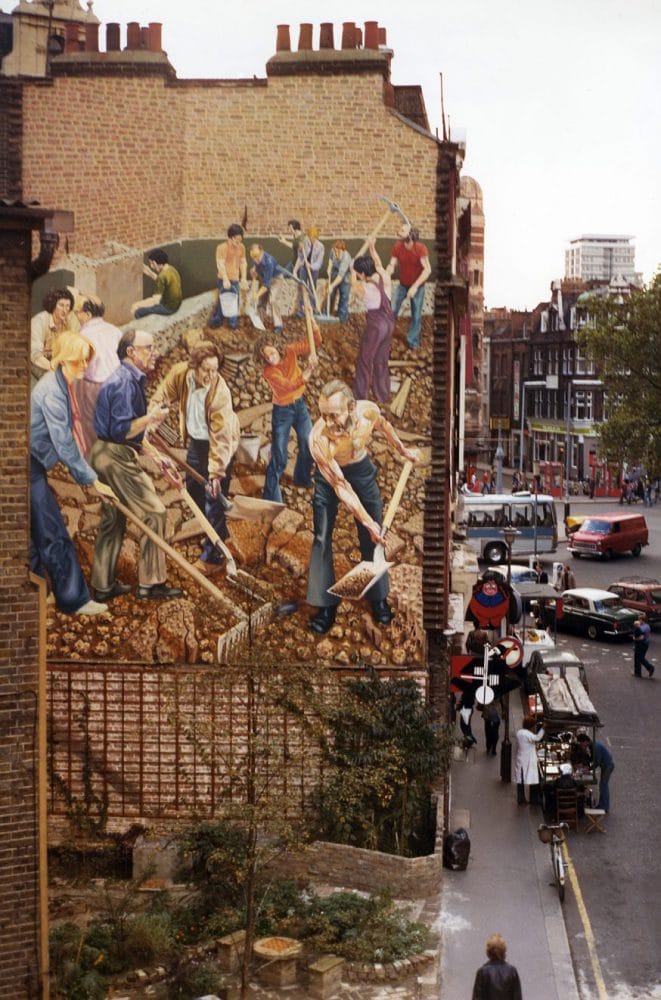Murals
Interviews
Stephen PuseyStephen Pusey, a former community activist, painted large outdoor community murals on the exteriors of buildings in Covent Garden and Brixton from 1977 to 1982.
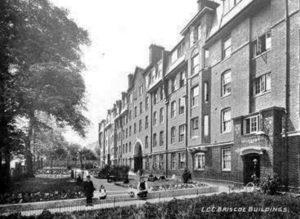 He was born in 1952 in Clapham. The family was initially poor and lived in a council flat without a bathroom on a rough estate at the top of Brixton Hill called Briscoe Buildings (now known as Renton Close since its conversion and renovation in 1961). Stephen takes pride in his family. His father came from India and worked hard in administrative jobs to keep the family afloat and was also a keen award-winning amateur photographer. His mother came from Ireland, was very well read, poetic, but by contradiction, pragmatic as well; she kept the home and organized their move to the Abbey Wood Estate in 1960. Stephen joined a gang on the estate. They got up to mischief by re-purposing building materials being used in the construction of Thamesmead into temporary habitats, were inventive and creative, played in the woods and on Thamesmead marshes, and on one occasion made off with a shunt train along the sewer bank that ran to Woolwich Arsenal. “Had I stayed there my creativity may have been put to a more criminal intent.”
He was born in 1952 in Clapham. The family was initially poor and lived in a council flat without a bathroom on a rough estate at the top of Brixton Hill called Briscoe Buildings (now known as Renton Close since its conversion and renovation in 1961). Stephen takes pride in his family. His father came from India and worked hard in administrative jobs to keep the family afloat and was also a keen award-winning amateur photographer. His mother came from Ireland, was very well read, poetic, but by contradiction, pragmatic as well; she kept the home and organized their move to the Abbey Wood Estate in 1960. Stephen joined a gang on the estate. They got up to mischief by re-purposing building materials being used in the construction of Thamesmead into temporary habitats, were inventive and creative, played in the woods and on Thamesmead marshes, and on one occasion made off with a shunt train along the sewer bank that ran to Woolwich Arsenal. “Had I stayed there my creativity may have been put to a more criminal intent.”
His parents eventually bought a house at the top of a hill in Erith, Kent. On failing the Eleven-Plus he went to a secondary school, where a new head-teacher turned the school around, from lazy negligence to aspiration.
“He basically saved the lives of a number of us, made it so that we could go on and take A levels, whereas previously we would have been destined to leave school at 15 and work in factories.”
He recalls, “Before I could paint I could write, it was the only way my teachers could discern I had any intelligence. Then round the age of sixteen I discovered I could draw and paint and that developed in leaps and bounds, I spent most of my time in the art room, my work had gone through realism, abstraction, and surrealism.”
He obtained four A levels, and was urged by the head and his parents to go to university, but was set on art school. “And they were right. I wouldn’t advise anyone to become an artist. It’s a very difficult life.”
secondary school, and he refuses university
Stephen applied to Saint Martins School of Art, was accepted for the foundation course and completed three further years there, studying fine art. During this time he had become interested in the political situation in Chile where Salvador Allende had established a socialist administration, carrying out a raft of left wing reforms, changing the balance of power from the wealthy landowners towards the common people, a cause – remembering his life on South London estates – close to Stephen’s heart. In 1973 a military coup engineered by the United States ousted the government. Sharing a house with Brazilian friends who worked for the International Coffee Organization he had access to unfiltered news of events which the the British press, likely also had access to, but did not report in detail. He and other artists, such as John Dugger, David Medalla, Cecilia Vicuna, Steve Sprung and others formed ‘Artists For Democracy’ and organized a major international exhibition in the Gulbenkian Hall at the Royal College of Art in 1974 in support of the MIR (the Chilean Revolutionary Left Movement). Many artists, including Claes Oldenburg, David Hockney and Roberto Matta contributed work to the exhibition for which Pusey created a large painting of Neruda and Allende.
After he left St Martins Stephen had a studio Covent Garden and became involved with the local community association in their mission to see that in moving the market to Nine Elms, the businesses, porters, inhabitants and the history and form of the place were protected. Two groups came together: one the indigenous conservative working class, and the other yuppies, students, artists and architects who were renting property there, many in short-life housing.
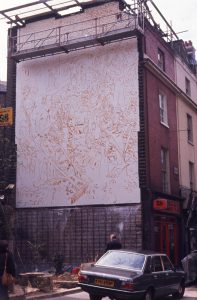 “There were empty sites like the one behind my studio in Long Acre (the former Odhams Press) which was just a huge bomb-site. “We designed and built these incredible gardens, and they were very professionally done, with hills, streams and bridges. And we’d put on festivals there. My first big mural was a product of working with that community. It shows people working, building a garden – the garden that is actually underneath the painting. In one corner there are friends, an architect, a porter with his shirt off, the person who owned the ironmongers – all were a part of the community. I made the portraits from photographs of the people as they were working and others I drew individually as well. It was all painted in oil-paints and as it was 1977, the year of the Queens Silver Jubilee, I was able to use the Royal Coat of Arms Insignia (above my short-life housing address at Peabody Buildings) to get free paint from Bollom’s paint store in Covent Garden and scaffolding from SGB. I made an eight foot by six foot painting and projected a photograph of the painting at night from a scaffold tower opposite the wall and then I and two assistants drew it out. It was quite rough. I then had sections of the painting printed as enlarged studies to work from on the scaffold. The funding came from the Arts Council. People were fascinated by it, saw it as a celebration, they called it “the Muriel” and complimented it. The artist was interviewed on the scaffold by Janet Street Porter for her TV series, “Punk Rock Magazines”, as well as various radio programmes.
“There were empty sites like the one behind my studio in Long Acre (the former Odhams Press) which was just a huge bomb-site. “We designed and built these incredible gardens, and they were very professionally done, with hills, streams and bridges. And we’d put on festivals there. My first big mural was a product of working with that community. It shows people working, building a garden – the garden that is actually underneath the painting. In one corner there are friends, an architect, a porter with his shirt off, the person who owned the ironmongers – all were a part of the community. I made the portraits from photographs of the people as they were working and others I drew individually as well. It was all painted in oil-paints and as it was 1977, the year of the Queens Silver Jubilee, I was able to use the Royal Coat of Arms Insignia (above my short-life housing address at Peabody Buildings) to get free paint from Bollom’s paint store in Covent Garden and scaffolding from SGB. I made an eight foot by six foot painting and projected a photograph of the painting at night from a scaffold tower opposite the wall and then I and two assistants drew it out. It was quite rough. I then had sections of the painting printed as enlarged studies to work from on the scaffold. The funding came from the Arts Council. People were fascinated by it, saw it as a celebration, they called it “the Muriel” and complimented it. The artist was interviewed on the scaffold by Janet Street Porter for her TV series, “Punk Rock Magazines”, as well as various radio programmes.
first mural: “People Build a Garden” Earlham Street in Covent Garden
The next mural was a commission from Bill Lewington of kids playing music in a class with Simon Rattle. “I painted the mural in oils as a series of four large panels in a Covent Garden studio that was lent to me by local developer and philanthropist, Christina Smith. The best of them was of a white boy and a black boy back to back like Siamese twins playing timpani drums with splayed tubular bells in the background. It was probably the most dramatic of the panels. Some months after it was installed at street level on the exterior of Bill Lewington’s music shop I walked by one morning to find that it had been burnt off the wall. It was a sickening sight. A fire had been started directly below the painting and I could only think that this was a racist attack.
Marsden Hospital Mural
Then I got a commission to paint a mural for the cancer ward in the Royal Marsden Hospital. It was of plants from Kew Gardens – a tropical forest – which was not in any way political, but was supposed to create an atmosphere that would be calming for people having radiation therapy. Following that Lambeth Council approached me to paint a mural and the Arts officer and I went round looking for walls and then I saw the fly-tower of the Brixton Astoria – possibly the biggest fly-tower in the UK – and said ‘There’s your wall! I like big things.’ ”
looking for a wall in Lambeth
Lambeth granted him eleven thousand pounds for the mural, which is thirty foot high and one hundred foot long with the top eighty foot from street level. He decided to use the Keim Silicate paint technique then coming into favour among muralists, one which produced the most durable exterior paint surface known. He spent two exhausting months up the scaffolding, drilling out the mortar lines on the enormous wall – and temporarily losing his hearing – to key the special calcine flint plaster to be used as a ground for the Silicate paint. As for the subject: it would be called, “Children At Play.”
“Following the Brixton riots there was a lot of tension in the area, so I thought I’d do a mural that celebrated racial harmony. So I went around the schools – even at my school we didn’t think about race, we just played with each other – only adults think about differences – and there are no differences – we are all the same as each other. So I took lots of photographs of children playing, and in the studio experimented with polyangular drawing to make the scaled drawing from which the mural was drawn out. Over the years I had grown to hate this painting! And then some years ago I saw some photographs of scaffolding surrounding it online and thought, ‘Oh great, they are going to pull it down.’ But no, this young woman, who had been a child at the time, Ruth Miller, had created the London Murals Preservation Society and they hired an artist, Paul Butler, to renovate the mural! And then another guy sent me an email saying he also had grown up with this mural and he had created this hip-hop music video about it because he thought it was fabulous and posted it on Youtube.
‘Children At Play’
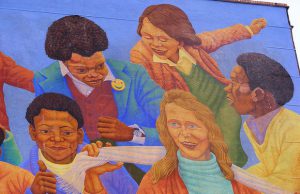 So I came to realize that even though it’s an awful painting it serves a function as all these murals do: they become a part of the community’s identity or they are a celebration of the community. People on Stockwell Park Estate look out on it all the time. This image of children playing perhaps promotes racial harmony in the neighbourhood. I just don’t feel it is a great painting. The Cable Street mural is a great painting, but then it wouldn’t be appropriate here.”
So I came to realize that even though it’s an awful painting it serves a function as all these murals do: they become a part of the community’s identity or they are a celebration of the community. People on Stockwell Park Estate look out on it all the time. This image of children playing perhaps promotes racial harmony in the neighbourhood. I just don’t feel it is a great painting. The Cable Street mural is a great painting, but then it wouldn’t be appropriate here.”
After that mural was completed in 1982, Stephen needed a break.
“The reason I’d become an artist in the first place was because I am a creature with imagination, making art is a release for that. I realized early on I had the ability to paint realistically and that was what was seen as art by the communities I was a part of, like Covent Garden for example, and because of the political ideals I subscribed to I felt it was important to make art that had a relevance to the community. But I was moving away from my personal reasons for making art. After that mural I traveled around Japan for some months.”
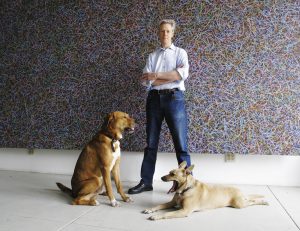 When he returned to the studio he went through a period of experimenting with different ways of making art, figurative, abstract and autonomic. Then he studied and made works about the Holocaust. He exhibited the show in New York at PS1 (now MoMA PS1) and over time, settled there. He speaks of producing works relating to the crisis of Aids, of discovering his facility with computers and their ability to make networks, of starting one of the first web-based art-sites in New York, Plexus.org, of being a founding member of the Foundation for Digital Culture – all of which he saw as a natural extension of his earlier community based work – but eventually returning to a more personal idiom. Stephen Pusey describes his current Abstract work, as it has been for some decades, as “autogenic” in nature and a return to somewhere parallel to where he first started making art.
When he returned to the studio he went through a period of experimenting with different ways of making art, figurative, abstract and autonomic. Then he studied and made works about the Holocaust. He exhibited the show in New York at PS1 (now MoMA PS1) and over time, settled there. He speaks of producing works relating to the crisis of Aids, of discovering his facility with computers and their ability to make networks, of starting one of the first web-based art-sites in New York, Plexus.org, of being a founding member of the Foundation for Digital Culture – all of which he saw as a natural extension of his earlier community based work – but eventually returning to a more personal idiom. Stephen Pusey describes his current Abstract work, as it has been for some decades, as “autogenic” in nature and a return to somewhere parallel to where he first started making art.
